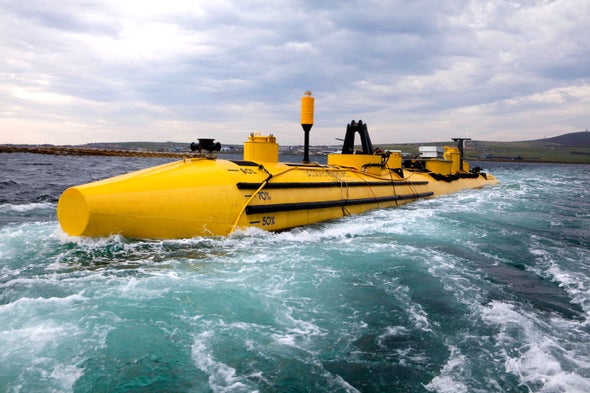Hidden in the ebb and flow of the tides is a wealth of energy. Primarily generated by the gravitational pull of the moon, tidal power is more predictable than wind, and it works well alongside solar power, generating electricity at night when the sun is down but when people fire up their computers, televisions, and other appliances. Globally, tidal power could potentially produce between 150 and 800 terawatt hours of renewable energy per year—at the upper end, that’s more than Canada’s energy production from wind, water, nuclear, fossil fuels, and other sources combined in 2019.
For tidal power generation, location is everything. To produce energy, tidal generators need fast currents or a sizable swing in sea level between high tide and low tide. The Bay of Fundy in Atlantic Canada, for instance, is an ideal candidate. Rising and falling by 12 meters, the bay has one of the largest tidal ranges in the world.
But a site’s currents and tidal range, and its potential for tidal power generation, is a complex consequence of myriad factors, including the basin’s width, length, and shape, the inflow from rivers, and the height of the sea. It’s this last variable—sea level—that threatens to throw a wrench in the world’s tidal power plans.
In a recent paper, scientists including Danial Khojasteh, a hydrodynamics expert at the University of New South Wales in Australia, show how sea level rise could upend the viability of tidal energy in sites around the world, turning presently prime spots into duds.
Khojasteh and his colleagues came to this conclusion after modeling 978 different hypothetical estuaries with varying shapes, tidal ranges, and rates of sea level rise, among other factors. While none of the estuaries were based on real locations, they could “reasonably represent the geometries of many, many estuaries worldwide,” says Khojasteh.
Of their 978 theoretical estuaries, a total of 54 had currents fast enough to drive tidal turbines. This number dropped to 47 in simulations with one meter of sea level rise. With two meters of sea level rise, it fell to 40. Even in estuaries that did keep their tidal power potential, Khojasteh says that in some the actual spot within the estuary where the water was moving at the necessary speed moved around.
Sea level rise is “going to displace, eliminate, or create new optimal sites across the system,” Khojasteh says.
For those looking to install tidal power generating infrastructure—equipment designed to last for decades—this could be a problem.
Robert Nicholls, an expert on sea level rise at the University of East Anglia in England who wasn’t involved in the research, says groups looking to build tidal energy farms “shouldn’t go into this blind. They should have a reasonable understanding of what’s likely to happen.”
However, Nicholls says projected sea level rise likely won’t have a large enough impact to seriously hinder tidal power generation. While it’s possible we might see one meter of sea level rise by the end of the century, he says tidal power operations might not last that long. In France, for instance, an operation planned for Brittany is expected to operate for 25 years. But the La Rance Tidal Power Station has been in operation since 1966 and is still generating power.
Yet energy infrastructure is often put to work well beyond its initial design lifetime. At the same time, tidal power is deceptively sensitive to changes in sea conditions. Power from tidal stream turbines, for example, is proportional to current velocity cubed, meaning that reducing the current speed by half reduces the power output to one-eighth. “Tidal energy is very, very sensitive to these changes,” says Ivan Haigh, a climatologist at the University of Southampton in England.
Drilling deeper into the patterns, Khojasteh and his colleagues found that certain kinds of estuaries will fare better at retaining their tidal power potential. For instance, turbines built in convergent estuaries—bodies of water that narrow inland—will persist better than those in estuaries that stay the same width upriver. With sea level rise, these convergent waterways narrow farther inland, funneling tidal energy through a smaller space. But even convergent estuaries will be, on the whole, worse for tidal power generation in the future.
Based on his own work, Haigh says there are a number of other ways sea level rise will affect tides. The two big ones, he says, are shifting amphidromic points and resonance.
Amphidromic points are locations where there is little to no tidal range. They form in large bodies of water like the North Sea but also in smaller bodies like Canada’s Hudson Bay, where lunar tides interact with the Earth turning on its axis. Near an amphidromic point, the tide moves in a big circle. Deeper water, caused by sea level rise, will move amphidromic points, causing nearby coasts to be hit with different high and low points of the tide.
The next factor, resonance, is familiar to anyone who’s ever pushed someone on a swing, Haigh says. When he’s pushing his daughter, if he pushes at exactly the right time, she will go higher and higher. But if he pushes her at the wrong time, like when she’s halfway up, it breaks the flow.
Each part of the coast has its own resonant frequency determined by its shape, width, and depth, Haigh says. The closer an area’s inherent resonant frequency is to the tidal cycle of the moon—12.42 hours—the bigger the tides will be. The Bay of Fundy’s resonant frequency is around 12.5 hours, which accounts for its gigantic tides. Sea level rise, though, can push an area’s resonant frequency closer to or farther away from the moon’s cycle, changing its local tidal range—and its viability for tidal power.
Right now, tidal energy is far from being a massive part of the world’s energy mix. But the field is growing, and as it does, it could be difficult to pick out ideal locations for turbines—particularly those that stay ideal long term. To get around this, Khojasteh says there should be more investment in making smaller, transportable tidal energy operations. “Otherwise, it’s going to be a big capital investment wasted.”
This story originally appeared in Hakai Magazine and is part of Covering Climate Now, a global journalism collaboration strengthening coverage of the climate story.


